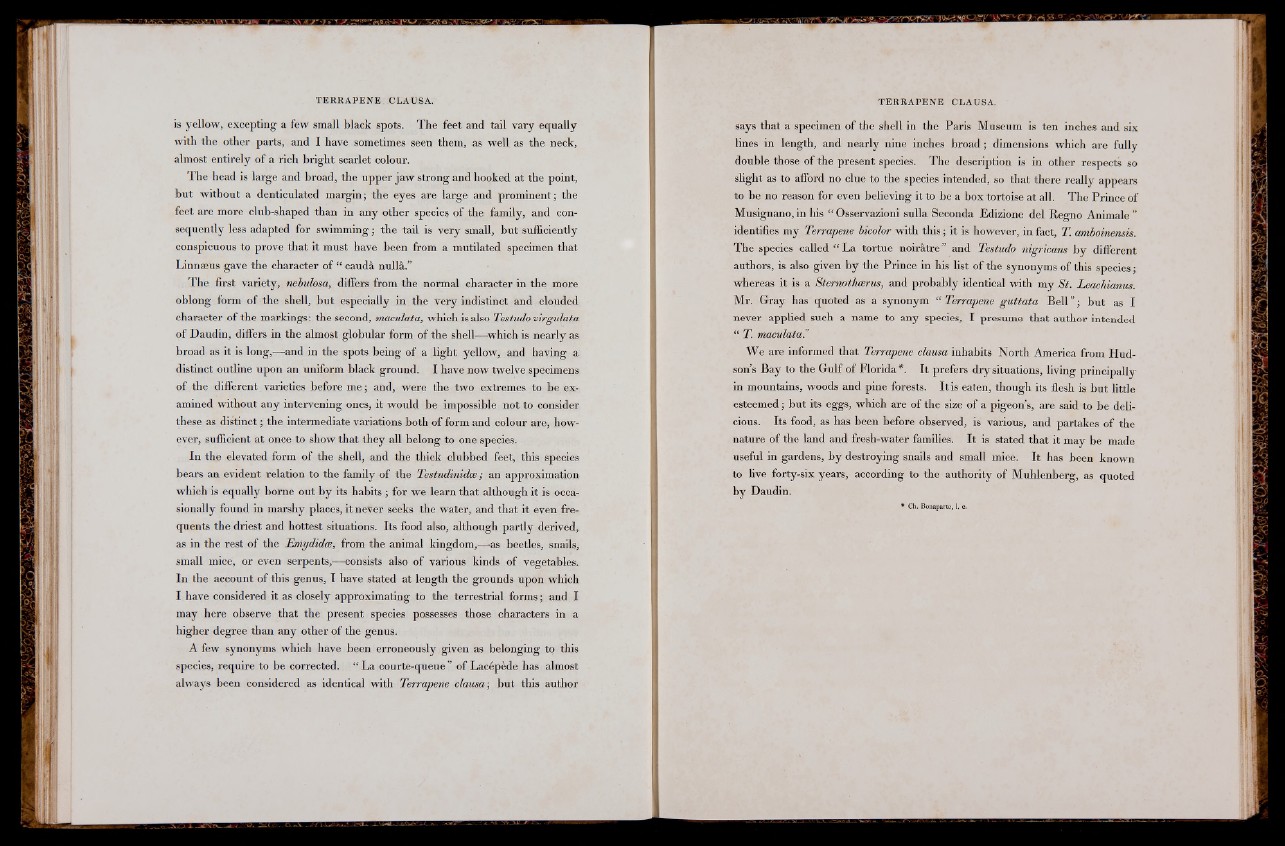
is yellow, excepting a few small black spots. The feet and tail vary equally
with the other parts, and I have sometimes seen them, as well as the neck,
almost entirely of a rich bright scarlet colour.
The head is large and broad, the upper jaw strong and hooked at the point,
but without a denticulated margin; the eyes are large and prominent; the
feet are more club-shaped than in any other species of the family, and consequently
less adapted for swimming; the tail is very small, but sufficiently
conspicuous to prove that it must have been from a mutilated specimen that
Linnaeus gave the character of “ cauda nulll”
The first variety, nebulosa, differs from the normal character in the more
oblong form of the shell, but especially in the very indistinct and clouded
character of the markings: the second, maculata, which is also Testudo virgulata
of Daudin, differs in the almost globular form of the shell—-which is nearly as
broad as it is long,—and in the spots being of a light yellow, and having a
distinct outline upon an uniform black ground. I have now twelve specimens
of the different varieties before me; and, were the two extremes to be ex>
amined without any intervening ones, it would be impossible not to consider
these as distinct; the intermediate variations both of form and colour are, however,
sufficient at once to show that they all belong to one species^
In the elevated form of the shell, and the thick clubbed feet, this species
bears an evident relation to the family of the Testudinidce; an approximation
which is equally borne out by its habits ; for we learn that although it is occasionally
found in marshy places, it never seeks the water, and that it even frequents
the driest and hottest situations. Its food also, although partly derived,
as in the rest of the Emydidce, from the animal kingdom,—as beetles, snails,
small mice, or even serpents,—consists also of various kinds of vegetables.
In the account of this genus, I have stated at length the grounds upon which
I have considered it as closely approximating to the terrestrial forms; and I
may here observe that the present species possesses those characters in a
higher degree than any other of the genus.
A few synonyms which have been erroneously given as belonging to this
species, require to be corrected. “ La courte-queue” of Lacepede has almost
always been considered as identical with Terrapene clausa-, but this author
says that a specimen of the shell in the Paris Museum is ten inches and six
lines in length, and nearly nine inches broad; dimensions which are fully
double those of the present species. The description is in other respects so
slight as to afford no clue to the species intended, so that there really appears
to be no reason for even believing it to be a box tortoise at all. The Prince of
Musignano, in his “ Osservazioni sulla Seconda Edizione del Regno Animale ”
identifies my Terrapene bicolor with this; it is however, in fact, T. amboinensis.
The species called “ La tortue noirktre” and Testudo nigricans by different
authors, is also given by the Prince in his list of the synonyms of this species;
whereas it is a Sternothwrus, and probably identical with my St. Leachianus.
Mr. Gray has quoted as a synonym “ Terrapene guttata Bell ”; but as I
never applied such a name to any species, I presume that author intended
“ T. maculata’ii:;s1
We are informed that Terrapene clausa inhabits North America from Hudsons
Bay to the Gulf of Florida*. It prefers dry situations, living principally
in mountains, woods and pine forests. It is eaten, though its flesh is but little
esteemed; but its eggs, which are of the size of a pigeon s, are said to be delicious.
Its food, as has been before observed, is various, and partakes of the
nature of the land and fresh-water families. It is stated that it may be made
useful in gardens, by destroying snails and small mice. It has been known
to live forty-six years, according to the authority of Muhlenberg, as quoted
by Daudin.
* Ch. Bonaparte, 1. c.